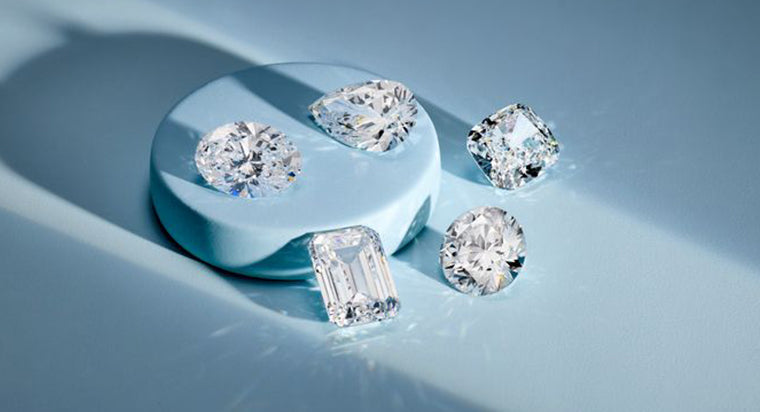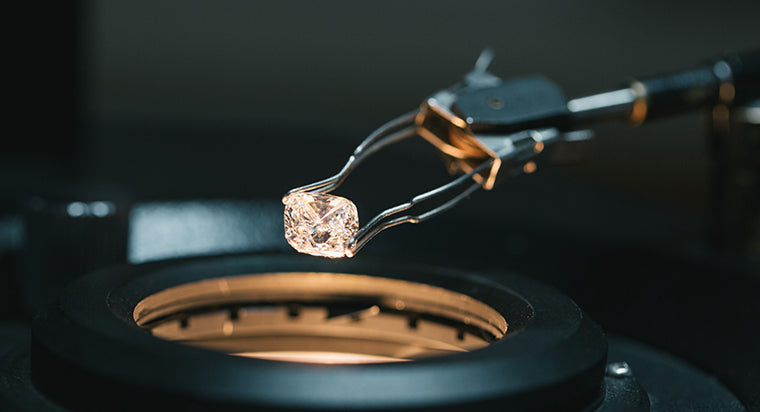What is Diamond Table?

Diamond cut is the most crucial aspect in creating a dazzling diamond. Contrary to popular belief, cut refers not to a diamond's shape (e.g. round, oval, pear, etc.) but to a diamond's proportions, symmetry and polish.
Diamond cut has three primary effects on appearance: brilliance (the brightness of reflected and refracted light), fire (the diamond's dispersal of light into flashes of visible color), and scintillation (flashes of light and dark--or sparkle--when a diamond or light source is moved).
TABLE OF CONTENTS
Depth and Table Percentage
The depth and table percentage of a diamond are the two factors that determine a diamond's cut. And as a diamond's largest facet, the diamond table plays a vital role in giving a diamond its signature sparkle. But what is the table of a diamond?
A diamond's table refers to the flat facet of the diamond seen when the stone is face up. The main purpose of a diamond table is to refract entering light rays and allow reflected light rays from within the diamond to meet the observer’s eye. The ideal table cut diamond will give the diamond stunning fire and brilliance.

Calculating Depth Percentage
In a diamond grading report, table percentages are calculated by dividing the table diameter by the average girdle diameter. For fancy shaped diamonds, diamond table percentages are calculated by dividing the table width by the width of the widest part of the diamond. Essentially, table percentages indicate the ratio of the width of the diamond's top facet (table) in relation to the width of the entire stone.
The perfect diamond table and depth percentages depend on the shape of the diamond--and one size does not fit all. The diamond table and depth percentages need to work in unison to refract and perfectly direct entering light onto the diamond's facets, allowing the light to bounce around and exit the table to the observer's eyes. When it comes to diamond tables, bigger is not always better. If the diamond table is too large, the upper facets on the crown will lack the room to disperse light. But if the diamond table is too small, not enough light will enter the stone, detracting from the diamond's overall brilliance.
Diamond Proportions & Cut
Diamond cut takes into account a diamond's proportions--the relationship between the size, shape, and angle of each diamond facet. A wide range of combinations are possible, and each diamond shape has a unique combination of ideal diamond depth and table percentages. Below are the Ideal Table & and Depth Percentages for all diamond shapes:
Diamond Depth and Table
| Shape | Ideal Table % | Depth % |
|---|---|---|
| Round | 53-58 | 59-62.3 |
| Princess | 67-72 | 64-75 |
| Oval | 53-63 | 58-62 |
| Emerald | 61-69 | 61-67 |
| Asscher | 61-69 | 61-67 |
| Marquise | 53-63 | 58-62 |
| Pear | 53-63 | 58-62 |
| Heart | 53-63 | 58-62 |
| Radiant | 61-69 | 61-67 |
| Cushion | 61-67 | 61-67 |
Significance of Table and Depth Percentage
Once you understand what makes an ideal diamond table percentage and diamond depth percentage, it's easy to see how a well proportioned diamond translates into diamond cut grades.
Diamond table and depth are two determining factors that affect a diamond's overall cut grade. Of all a diamond's 4 C's, cut is the most complex and technically difficult to analyze. In order to grade cut, laboratories calculate the proportions of the facets that influence the diamond's face-up appearance, thus evaluating how successfully a diamond interacts with light to create brightness, fire, and scintillation—all aspects of a diamond's signature brilliance. A diamond's cut grade also considers the design and craftsmanship of the diamond, including its weight relative to its diameter, its girdle thickness, symmetry of facet arrangement, and the polish quality.
GIA, EGL Diamond Cut Classifications
From there, the diamond's cut is graded on a scale, often differing by the laboratory performing the diamond grading. The Gemological Institute of America and European Gemological Laboratory classify diamond cut on a scale comprised of the categories Excellent, Very Good, Good, Fair, and Poor while the American Gem Society uses a numerical scale from zero to ten.
While many people opt to follow the saying “bigger is better” for diamond size or carat size, cut, and thus diamond table percentage, is much more complex. As diamond table plays a crucial role in determining the most influential of a diamond's four C's, take the time to research the ideal diamond table percentage for your desired diamond.
FAQs
What is a diamond's table?
How to calculate depth percentage?
How is a diamond's cut graded?








